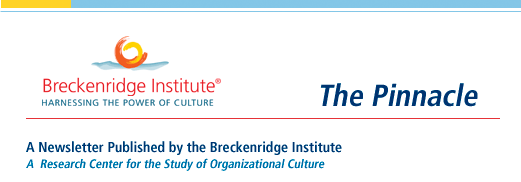Root Causes of Conflict in Work-Groups
Studies have shown that over 85% of the root causes of organizational performance problems are in the structures, systems, and culture within which work-groups are embedded. Structures and systems are either consciously defined with purpose and intent around a strategic direction as an Intended Culture, or they emerge naturally from the patterns-of-interaction of the personalities of managers and staff within work-groups, departments, and functional units as an Unintended Culture. Unintentionally designed structures and systems that create contention between managers are the single biggest cause of destructive conflict in work-groups. So focusing on conflict in a “work-group” without understanding the structures, systems, and culture within which it is embedded almost guarantees that change will not be sustainable, because the managers and staff within the work-group are less than 15% of the real problem. Identifying the root causes of conflict in work-groups should always begin by asking four key questions:
- How much of the conflict within the work-group is being created by the organizational structures, systems, and culture that are outside the work-group?
- How much of the conflict within the work-group is in response to dynamic forces and pressures that originate from outside the work-group, or from the external environment; e.g., changing levels of revenue, competitors, customer demands, the efficiency of enterprise-wide business processes or functional units that support the work-group, etc?
- How much of the conflict within the work-group is being created by interacting with other organizational units (or groups outside the organization) that operate from different disciplinary paradigms?
- How much control can the work-group exert over these factors?
The answers to these and other questions will allow you to begin evaluating the root causes of performance issues and destructive conflict that come from outside the work-group in a more systematic and rigorous way. They will enable you to better: a) understand how individual group members with specific personalities are likely to respond when subjected to these external forces and pressures, b) anticipate the kinds of conflict-processing strategies that group members are likely to propose in response to organizational forces and pressures, c) utilize both-and-thinking to decrease the probability of destructive conflict and create better business solutions in day-to-day operations, and d) manage the levels of destructive and constructive conflict between team members to ensure that the climate within the work-group is positive and motivating, rather than negative and counter-productive.
Read More...
Culture Talk™
Learn what organizational culture is and why it matters by watching Culture Talk™ – an on-line video series that explores key questions about organizational culture and how it powerfully affects day-to-day operations and the bottom-line in your organization.
Culture Talk™ Video Series
For more information on the Breckenridge Institute’s unique approach to improving your organization’s performance and sustainability go to breckenridgeinstitute.com or contact us at info@breckenridgeinstitute.com.
Organizational Impasse Indicator™
Does your organization find it difficult to make key decisions, and once made do they go unimplemented or get reversed? Do projects that seem to have the full support of top managers and key personnel die a slow death and no one knows what happened to them? Does your organization’s culture act like an Invisible Bureaucracy™ that prevents you from getting the results you want? These are some of the signs that your organization has reached an impasse. The Breckenridge Institute’s free Organizational Impasse Indicator™ will show you what this may be costing you in squandered time and energy – hidden costs that don’t appear on Balance Sheets or Budget Statements.
Free Organizational Impasse Indicator™
Just click on the link above, complete the questions in 2-3 minutes, and your free Organizational Impasse Indicator™ report will be sent directly to you. This is the first step to making invisible bureaucracy visible and to moving beyond the organizational impasses that prevent your organization from getting the results it wants.
HBR Editor’s Blog
Every month, the senior editors of the Harvard Business Review (HBR) invite internationally recognized organizational theorists and practitioners to raise issues and answer questions about leadership and management issues on the HBR Editor’s Blog. This month, we provide Pinnacle readers with links to two important and interesting discussions (see below).
Elizabeth Haas Edersheim, The BP Culture’s Role in the Gulf Oil Crisis
John T. Landry, What a Culture of Candor Really Takes
We encourage you to join the conversation on the HBR Editor’s Blog and voice your opinions, commentary, and insights on these and other important topics.
Update
| • |
Mark Bodnarczuk’s book, Making Invisible Bureaucracy Visible: A Guide to Assessing and Changing Organizational Culture is available at on-line world-wide at locations like Amazon.com. |
| • |
The Breckenridge Institute® is now using Michael Goldberg’s book, The 9 Ways of Working with its BTI™ certification programs and publicly available workshops. Goldberg’s book provides valuable insight into how co-workers and bosses think, what they want, and why they act the way they do. |
| • |
Mark Bodnarczuk recently spoke about his book, Making Invisible Bureaucracy Visible at the International Atomic Energy Agency in Vienna (see www.iaea.org). |
| • |
For a more complete listing of on-line videos, books, articles, and white papers from the Breckenridge Institute® go to http://www.breckenridgeinstitute.com/our-publications.htm. |
Breckenridge Institute®
If you would like information about the Breckenridge Institute’s research
activities, portfolio of assessment tools, or consulting
services, visit our website at www.breckenridgeinstitute.com. Also visit http://www.linkedin.com/in/markbodnarczuk.
Copyright © Breckenridge Institute® 2010. All Rights Reserved
Underwater Photo: © Annie Crawley, 2010, www.anniecrawley.com
|



